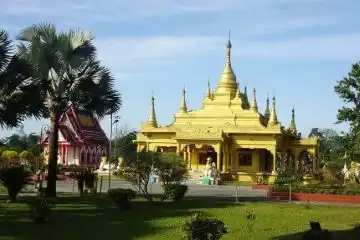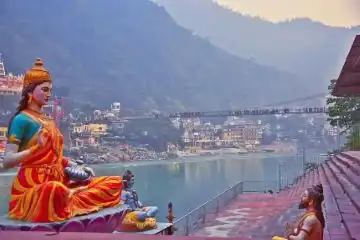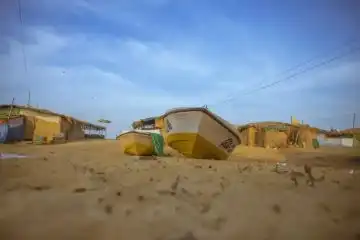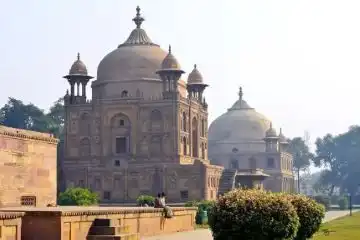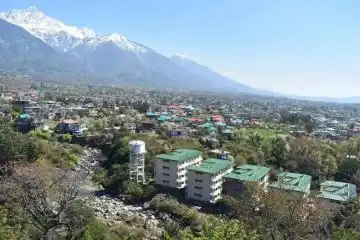Explore the famous Buddhist culture and heritage of Itanagar
Set against the lush hills of Arunachal Pradesh, the town of Itanagar. The Buddhist culture and heritage of Itanagar are expressed through sacred monasteries, vibrant festivals, ancient customs, and the enduring influence of Himalayan traditions. Itanagar offers a rare glimpse into the spiritual depth and cultural richness of Northeast India. Known for its natural beauty and tribal diversity, Itanagar also harbors a deeply rooted connection to Buddhism. This comprehensive guide takes you through the spiritual heart of Itanagar. That is meanwhile perfect for history lovers, culture enthusiasts, and mindful travelers alike.
1. Itanagar Gompa: A Beacon of Peace and Faith
Begin your journey to explore Buddhist culture and heritage of Itanagar at the revered Itanagar Gompa. Firstly, it is one of the city's most prominent Buddhist landmarks. Built in the 1980s, this peaceful monastery stands further tall overlooking the capital. The vibrant yellow roof and tiered architecture draw inspiration from Tibetan designs. Inside, a large statue of Buddha sits in meditative poise, surrounded by colorful murals and sacred scriptures. However, you can plan a trip to explore the top temples and historical attractions in Bardhaman West Bengal. Pilgrims and tourists alike come here to pray, meditate, or simply take in the panoramic view of Itanagar nestled in the hills below.
2. Understanding the Mahayana Buddhist Philosophy
The dominant Buddhist school in Itanagar is Mahayana Buddhism. That emphasizes altruism and the Bodhisattva path-helping others achieve enlightenment. This philosophy permeates every aspect of spiritual life here, from ritual chants to acts of daily compassion. Visitors can witness monks reciting sutras, practicing mindfulness, and guiding community events. That meanwhile reflect the true spirit of Mahayana teachings. The emphasis on collective well-being makes the Buddhist culture and heritage of Itanagar feel both personal and communal.
3. Losar and Other Festivals of Buddhist Itanagar
Festivals bring the Buddhist ethos to life. The most significant celebration is Losar, marking the Tibetan New Year. Houses are cleaned, prayer flags are renewed, and monasteries hold special rituals to drive away negative spirits. Buddha Jayanti, another key festival, commemorates the birth, enlightenment, and death of Lord Buddha. Devotees firstly offer flowers, light lamps, and engage in group meditations. These festivals are not only religious occasions-but they're also windows into a vibrant spiritual lifestyle.
4. Buddhism Beyond Borders: Dalai Lama's Visits and Legacy
Although His Holiness the Dalai Lama hasn't resided in Itanagar. But, his visits to Arunachal Pradesh have greatly influenced the region's spiritual environment. His travels through Tawang and interactions with the Monpa people have left a legacy of peace and mindfulness. That meanwhile echoes in Itanagar. His teachings, often broadcast or printed, are revered by monks and laypeople alike. They further anchor the city to the broader Himalayan Buddhist tradition.
5. Tibetan Settlement and Preservation of Sacred Art Forms
A lesser-known aspect of Buddhist culture and heritage of Itanagar is the Tibetan refugee settlement located on its outskirts. Established decades ago, this peaceful enclave plays a vital role in preserving Tibetan-Buddhist culture. Here, artisans create traditional thangka paintings, mani stones, and ceremonial robes. These creations aren't merely decorative. They further serve as visual prayers, teaching tools, and spiritual offerings. Above all, visitors are welcome to observe or even participate in workshops. With that, they can meanwhile gain deeper insight into Buddhist artistry.
6. Monpa Cultural Presence in the Capital
The Monpa tribe is indigenous to Arunachal Pradesh. It brings its unique perspective to Buddhist culture and heritage of Itanagar. Their traditions combine animistic beliefs with Buddhist philosophy. That meanwhile creates a unique cultural blend. Monpa monks often conduct ceremonies at the Itanagar Gompa and participate in festivals. Their traditional dress, prayer chants, and community rituals further enrich the spiritual tapestry of the city. Try to learn about the Monpa way of life giving context to the current Buddhist culture and heritage of Itanagar.
7. Sacred Symbols: Spirituality in Everyday Life
Walk through Itanagar, and you'll spot countless prayer wheels, Buddhist stupas, and sacred mantras carved into stones. These symbols are not mere décor. They further serve as constant reminders of impermanence, compassion, and the Eightfold Path. Locals often spin prayer wheels as they pass, reciting mantras like “Om Mani Padme Hum”. These sacred practices ground Buddhist values in daily life. That meanwhile make spirituality accessible and visible throughout the city.
8. Meditation Centers and Spiritual Retreats
Apart from monasteries, Itanagar also offers quiet corners and structured retreats for meditation. A few spiritual centers around the city organize weekend workshops and silent retreats. That are based on Vipassana and Mahayana meditation styles. These sessions are often led by senior monks. They meanwhile offer teachings on mindfulness, loving-kindness, and detachment. Such experiences allow travelers to not only observe but also deeply engage with the spiritual heritage of the region.
9. Educational Institutes and Monastic Schools
Education plays a vital role in preserving Buddhist philosophy in Itanagar. The Buddhist Cultural and Religious Study Centers are often run by monasteries. They firstly provide free education in Pali, Tibetan language, and Buddhist scriptures. Children from nearby districts come here to study under monks, learning both spiritual and secular subjects. These monastic schools further ensure the continuity of teachings. That maintain a strong lineage of Buddhist wisdom in the capital.
10. Architectural Harmony with Nature
Buddhist structures in Itanagar often reflect a deep harmony with the environment. Most monasteries are built using locally sourced materials for example stone, wood, and clay. They are built with architecture that complements the natural slope of the land. The vibrant reds and golds of gompas stand in contrast to the emerald green forests. That meanwhile symbolizes enlightenment rising from nature. This architectural approach is both symbolic and sustainable, a lesson in mindful construction.
11. Day Trips to Neighboring Buddhist Hotspots
For those with extra time, Itanagar serves as a perfect base to explore surrounding Buddhist sites. Some of them are for example Bomdila, Ziro, and Tawang. Each destination further offers its own blend of Buddhist art, literature, and devotion. Ziro is particularly known for its tribal and Buddhist fusion. While Tawang's 17th-century monastery is one of the largest in India. These places enrich your understanding of how interconnected the Buddhist culture and heritage of Itanagar is with the rest of Arunachal Pradesh.
12. Buddhism and Community Life
Buddhism in Itanagar isn't confined to temples-it permeates community decisions, celebrations, and even conflict resolution. The local Buddhist council often mediates disputes through dialogue, guided by Dharma-based ethics. Volunteers also organize food donation drives, environmental clean-ups, and literacy campaigns inspired by Buddhist values. This sense of engaged Buddhism makes the religion a lived experience and a powerful force for societal cohesion.
13. Pilgrimage and Spiritual Tourism
In recent years, Itanagar has seen a rise in spiritual tourism, with travelers seeking authentic, offbeat Buddhist experiences. Many include Itanagar as part of a pilgrimage circuit along with Tawang and Bomdila. Guided tours often include temple visits, cultural performances, and local meals in monasteries. This form of tourism meanwhile supports local communities. It further gives travelers immersive experiences rooted in the region's spiritual heritage.
Conclusion: A Journey into Mindfulness and Culture
The Buddhist culture and heritage of Itanagar go far beyond the walls of a monastery. They further echo through festivals, traditions, art, and everyday life. You may be drawn by the peaceful chants of monks or the intricate details of a thangka painting or the warm hospitality of local communities. Itanagar invites you to pause, reflect, and connect with something deeper. In this hill city, Buddhism is not only a belief-but also a way of life. That continues to shape the present while honoring the ancient past.


